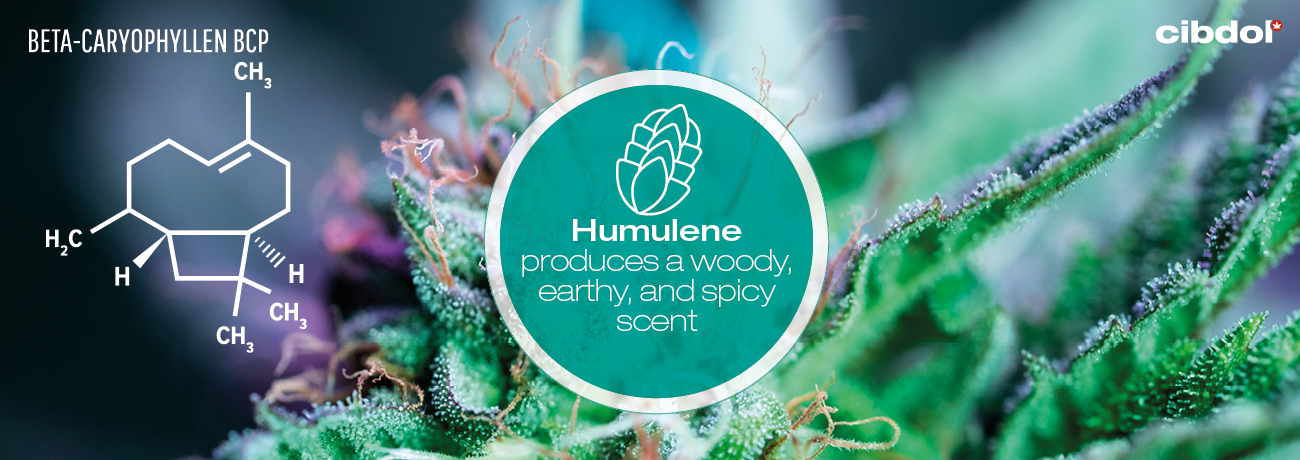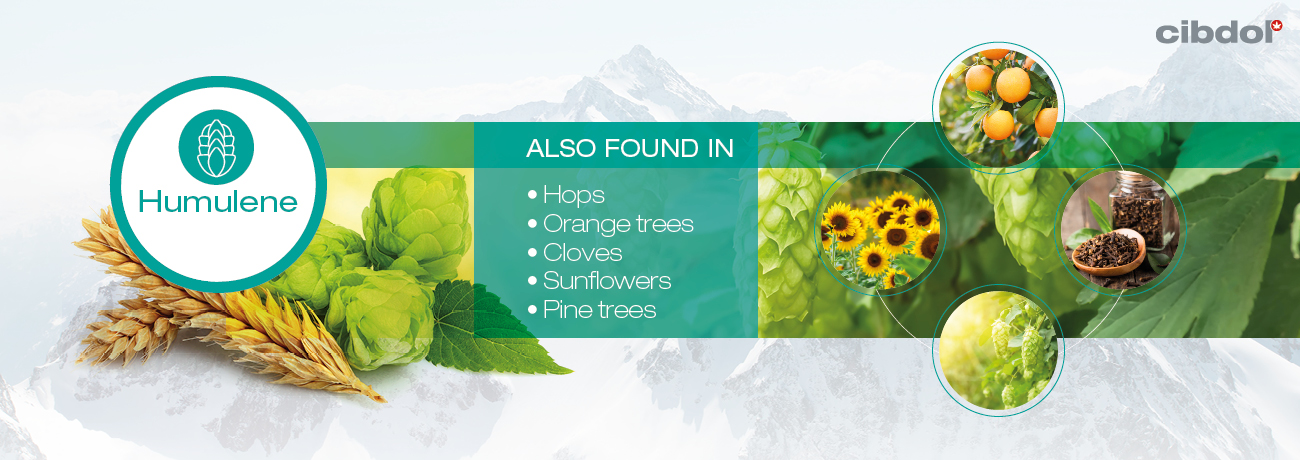What is Humulene?

As a major component in the cannabis plant phytocomplex, humulene, also known as α-humulene or α-caryophyllene, contributes to the discernable scent of cannabis flowers. Early research also suggests that the terpene might contribute to the plant's therapeutic potential.
Humulene appears as one of hundreds of chemical constituents found in cannabis resin. Due to the three isoprene units in its structure, it belongs to the sesquiterpene class.
In recent times, researchers have turned their attention towards terpenes as potential medicinal sources—humulene being no exception. Although cannabinoids provide the primary effects of the cannabis plant, terpenes are thought to synergise with these molecules, as well as provide their own unique effects.
Aroma
Humulene produces a woody, earthy, and spicy scent. The molecule underpins the aroma of numerous cannabis cultivars, culinary herbs, and traditional medicinal herbs.
Also found in
Have you ever cracked open a bottle of your favourite India pale ale and swore you caught a whiff of cannabis? Well, humulene might have been at the root of your curiosity.
Why? Humulene occurs in large quantities in the essential oil of hops—a plant used to flavour beer during the brewing process. Interestingly, both cannabis and hops are members of the Cannabaceae family.
Hops are the flowers of the hop plant (Humulus lupulus) and contain up to 40% humulene in their extract.
Cannabis and hops aren’t the only plant sources of humulene. The molecule can be found in plants from every continent on Earth, very often alongside its counterpart caryophyllene. The two terpenes share the same formula, but their atoms are featured in different arrangements.
Research has found high levels of humulene in the atmosphere around certain crops and wild plants, including pine trees, orange trees, marsh elders, tobacco, and sunflowers.
The terpene also makes up a large part of the essential oils of sage, Japanese spicebush, ginger, Chinese laurel tree, and Vietnamese coriander.
Humulene plays the role of a secondary metabolite in these plants, working to protect them against pest insects. Interestingly, it appears to do so by interrupting reproduction. Research[1] found humulene to reduce the mating success of Mediterranean fruit flies.

Possible effects
So far, humulene has demonstrated the following effects:
• Anti-inflammatory
• Antitumour
• Antibacterial
Let’s take a look at some of the supporting research below:
Supporting research
Humulene has demonstrated therapeutic potential in cell and animal studies. Unfortunately, there aren’t any clinical trials to confirm these effects in humans. For now, this early research serves to indicate what future human studies might find.
• Anti-inflammatory
A study[2] in the European Journal of Pharmacology explored the anti-inflammatory potential of humulene. Researchers induced swelling in the paws of rats and mice, then orally administered the terpene.
They found that humulene was able to reduce the number of inflammatory molecules, and the effects were even comparable to those produced by anti-inflammatory drugs. Researchers concluded that humulene and β-caryophyllene "might represent important tools for the management and/or treatment of inflammatory diseases".
Research[3] published in the British Journal of Pharmacology tested humulene on an experimental model of allergic asthma in mice. Symptoms of this condition include airway hyperresponsiveness, eosinophilic (a type of white blood cell) inflammation, and hypersecretion of mucus.
Humulene demonstrated marked anti-inflammatory properties against airway inflammation when administered orally or as an aerosol. The researchers stated that their findings point towards the terpene as an attractive molecule in the treatment of asthma and inflammation-related allergies.
• Antitumour
A 2003 study published in the journal Planta Medica demonstrates the antitumour potential of humulene.
The research began with scientists testing the essential oil of balsam fir—a tree widespread in Canada—on several types of tumour cells. They found the oil to be effective against all of the cell lines tested.
They went on to analyse the oil using gas chromatography, finding humulene to be the active constituent against the tumour cells.
The researchers found that humulene might produce its antitumour effect by decreasing cellular glutathione levels and boosting levels of reactive oxygen species (ROS). ROS are known to play a role in apoptosis[4]—the natural and controlled death of cells.
Further research published in the journal Cancer Cell & Microenvironment tested a humulene-rich essential oil on colorectal cancer cells. They obtained the oil from the leaves of Myrica rubra (yumberry), a subtropical fruit tree found in Asia and used in traditional medicine.
Researchers found the oil to reduce tumour invasion, diminish metastasis (secondary growth), and induce apoptosis.
• Antibacterial
Humulene appears to possess antibacterial properties. A research article[5] featured in Phytotherapy Research suggests that humulene can combat Staphylococcus aureus, a bacterial strain that causes skin infections, bone infections, and pneumonia.
The study tested balsam fir oil against several types of bacteria. The researchers suggest that humulene—although a minor component of the oil—managed to produce effective action against Staphylococcus aureus.
[1] Russo, E. B., & Marcu, J. (2017). Cannabis Pharmacology: The Usual Suspects and a Few Promising Leads. Cannabinoid Pharmacology, 67–134. https://doi.org/10.1016/bs.apha.2017.03.004 [Source]
[2] Fernandes, E. S., Passos, G. F., Medeiros, R., da Cunha, F. M., Ferreira, J., Campos, M. M., Pianowski, L. F., & Calixto, J. B. (2007). Anti-inflammatory effects of compounds alpha-humulene and (−)-trans-caryophyllene isolated from the essential oil of Cordia verbenacea. European Journal of Pharmacology, 569(3), 228–236. https://doi.org/10.1016/j.ejphar.2007.04.059 [Source]
[3] Rogerio, A. P., Andrade, E. L., Leite, D. F., Figueiredo, C. P., & Calixto, J. B. (2009). Preventive and therapeutic anti-inflammatory properties of the sesquiterpene α-humulene in experimental airways allergic inflammation. British Journal of Pharmacology, 158(4), 1074–1087. https://doi.org/10.1111/j.1476-5381.2009.00177.x [Source]
[4] Redza-Dutordoir, M., & Averill-Bates, D. A. (2016). Activation of apoptosis signalling pathways by reactive oxygen species. Biochimica et Biophysica Acta (BBA) - Molecular Cell Research, 1863(12), 2977–2992. https://doi.org/10.1016/j.bbamcr.2016.09.012 [Source]
[5] Pichette, A., Larouche, P. L., Lebrun, M., & Legault, J. (2006). Composition and antibacterial activity ofAbies balsamea essential oil. Phytotherapy Research, 20(5), 371–373. https://doi.org/10.1002/ptr.1863 [Source]
[1] Russo, E. B., & Marcu, J. (2017). Cannabis Pharmacology: The Usual Suspects and a Few Promising Leads. Cannabinoid Pharmacology, 67–134. https://doi.org/10.1016/bs.apha.2017.03.004 [Source]
[2] Fernandes, E. S., Passos, G. F., Medeiros, R., da Cunha, F. M., Ferreira, J., Campos, M. M., Pianowski, L. F., & Calixto, J. B. (2007). Anti-inflammatory effects of compounds alpha-humulene and (−)-trans-caryophyllene isolated from the essential oil of Cordia verbenacea. European Journal of Pharmacology, 569(3), 228–236. https://doi.org/10.1016/j.ejphar.2007.04.059 [Source]
[3] Rogerio, A. P., Andrade, E. L., Leite, D. F., Figueiredo, C. P., & Calixto, J. B. (2009). Preventive and therapeutic anti-inflammatory properties of the sesquiterpene α-humulene in experimental airways allergic inflammation. British Journal of Pharmacology, 158(4), 1074–1087. https://doi.org/10.1111/j.1476-5381.2009.00177.x [Source]
[4] Redza-Dutordoir, M., & Averill-Bates, D. A. (2016). Activation of apoptosis signalling pathways by reactive oxygen species. Biochimica et Biophysica Acta (BBA) - Molecular Cell Research, 1863(12), 2977–2992. https://doi.org/10.1016/j.bbamcr.2016.09.012 [Source]
[5] Pichette, A., Larouche, P. L., Lebrun, M., & Legault, J. (2006). Composition and antibacterial activity ofAbies balsamea essential oil. Phytotherapy Research, 20(5), 371–373. https://doi.org/10.1002/ptr.1863 [Source]





